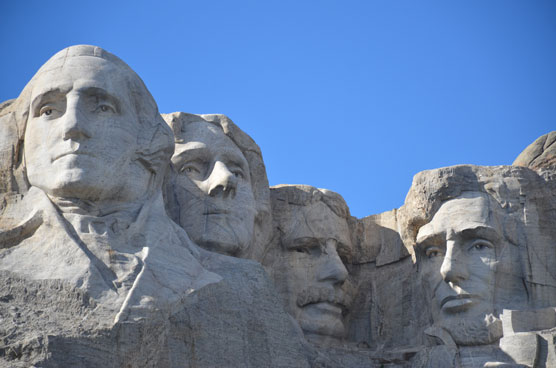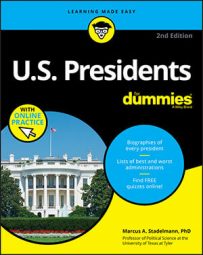The successes and failures of the chief executive have become a staple of U.S. culture. Every year, the media spends thousands of hours disseminating information on their virtues and shortcomings. Their biographies become best sellers. The public marvels at their childhood plights and adult accomplishments. Stories about their personal lives and office conduct have become ingrained in American culture and literature. The public revels in the presidents’ personal shortcomings and failures, and eagerly laps up scandals involving them.
 ©Camboy Artistry/Shutterstock.com
©Camboy Artistry/Shutterstock.comKey Dates in U.S. Presidential History
In the following table, find important dates and key events that occurred to U.S. presidents throughout history.
| April 19, 1775 | The Revolutionary War breaks out after Colonial militia and British soldiers exchange fire at Lexington and Concord, Massachusetts. |
| July 4, 1776 | The Continental Congress ratifies the Declaration of Independence. |
| March 1, 1781 | The Constitutional Congress adopts the Articles of Confederation, creating the first form of government for the United States. |
| September 3, 1783 | Great Britain and the United States sign the Treaty of Paris, ending the Revolutionary War. |
| September 17, 1787 | The Constitutional Convention meets in Philadelphia and approves the new U.S. Constitution. |
| June 21, 1788 | The Constitution goes into effect after New Hampshire becomes the ninth state to approve the document. |
| February 4, 1789 | George Washington is unanimously elected the first president of the United States. |
| April 30, 1789 | George Washington is inaugurated as the first president of the United States. |
| December 15, 1791 | The Bill of Rights, or the first ten amendments to the Constitution, goes into effect. |
| September 17, 1796 | Newspapers publish Washington’s farewell address in which he urges the country to stay out of European affairs and instead become isolationist. |
| February 24, 1803 | The U.S. Supreme Court, in Marbury v. Madison, establishes the principle of judicial review, meaning that the Supreme Court has the power to declare acts of Congress unconstitutional. |
| May 2, 1803 | President Jefferson buys 828,000 square miles from France for $15 million, or 3 cents an acre. The acquisition, known as the Louisiana Purchase, almost doubles the size of the country overnight. |
| June 18, 1812 | The War of 1812, against Great Britain, breaks out during President Madison’s administration. The conflict lasts until 1814, with neither side gaining anything tangible. |
| February 22, 1819 | President Monroe buys Florida from Spain for $5 million. |
| February 17, 1820 | Congress, during the Monroe administration, passes the Missouri Compromise, which outlaws slavery in the territory of the Louisiana Purchase north of the 36°30′ parallel. |
| May 13, 1846 | The Mexican-American War, during which the United States conquers most of the American Southwest, including California, begins during the Polk administration. |
| May 26, 1854 | The Kansas-Nebraska Act passes the Senate, formally repealing the Missouri Compromise of 1820 and setting the foundation for the Civil War. President Pierce signs the act into law. |
| November 6, 1860 | Abraham Lincoln is elected president of the United States. |
| December 20, 1860 | South Carolina secedes from the Union, with President Buchanan sitting by idly. |
| February 4, 1861 | Six Southern states create the Confederate States of America. Five more Southern states join the Confederacy before the year is over. |
| April 12, 1861 | The Civil War begins when Confederate troops attack Fort Sumter in South Carolina. |
| January 1, 1863 | President Lincoln’s Emancipation Proclamation, which declared all slaves in the Confederacy to be free, takes effect. |
| July 1–3, 1863 | The battle of Gettysburg turns the war to the North’s favor. |
| April 8, 1865 | General Lee surrenders to General Grant, signaling an end to the Civil War. |
| April 14, 1865 | Actor John Wilkes Booth, a Southern sympathizer, assassinates President Lincoln. |
| May 16, 1868 | The Senate votes to impeach President Johnson, 35 to 19. Impeachment fails by one vote. |
| November 7, 1876 | Republican Rutherford Hayes loses the popular vote and the electoral vote in the presidential election, but a special Electoral Commission overturns the election and makes him president in March 1877. |
| May 18, 1896 | The U.S. Supreme Court rules in Plessy v. Ferguson that segregation is legal if equal access and accommodation are provided for African Americans. |
| April 25, 1898 | At President McKinley’s urging, Congress declares war on Spain, resulting in the Spanish-American War and allowing the United States to take over Cuba, the Philippines, Guam, and Puerto Rico. |
| November 18, 1903 | During President Theodore Roosevelt’s first term, the United States receives permanent rights to build and own a canal in Panama. |
| August 5, 1912 | Former president Theodore Roosevelt becomes the presidential nominee for the Bull Moose Party and receives 27 percent of the vote, the best third-party showing in United States history. |
| February 25, 1913 | The 16th Amendment to the Constitution allows the federal government to impose an income tax. |
| April 6, 1917 | During President Wilson’s second term, the United States enters World War I on the side of the Allies in Europe. |
| November 19, 1919 | The U.S. Senate refuses to ratify the Versailles Treaty, which established the League of Nations, despite the fact that the League of Nations was President Wilson’s idea. |
| August 26, 1920 | President’s Wilson’s final accomplishment, the 19th Amendment, which gives women the right to vote, goes into effect. |
| October 29, 1929 | Black Tuesday — a crash of the stock market — signals the start the Great Depression. |
| March 4, 1933 | Franklin Delano Roosevelt is inaugurated and starts his New Deal programs. |
| August 14, 1935 | President Franklin Roosevelt signs social security legislation establishing a pension plan in the United States. |
| December 7, 1941 | Japan attacks the U.S. military installation in Pearl Harbor, Hawaii. At President Franklin Roosevelt’s urging, the United States declares war on Japan and enters World War II. |
| November 7, 1944 | President Franklin Roosevelt wins an unprecedented fourth term in office. |
| August 6, 1945 | President Truman orders the first atomic bomb be dropped on Japan. |
| September 2, 1945 | Japan surrenders, ending World War II. |
| June 25, 1950 | North Korea invades South Korea, forcing President Truman to react, and in turn starting the Korean War. |
| February 26, 1951 | During President Truman’s administration, the 22nd Amendment to the Constitution passes, limiting U.S. presidents to two terms. |
| May 17, 1954 | The U.S. Supreme Court, in Brown v. the Board of Education of Topeka, Kansas, rules that the segregation of public schools is unconstitutional. President Eisenhower enforces the ruling. |
| November 22, 1963 | President Kennedy is assassinated in Dallas, Texas. |
| July 2, 1964 | President Johnson signs the Civil Rights Act, prohibiting discrimination on the basis of color, gender, or religion. |
| June 18, 1970 | President Nixon signs legislation giving 18-year-olds the right to vote. |
| January 22, 1973 | The U.S. Supreme Court rules in Roe v. Wade that abortions are legal in the United States. |
| January 27, 1973 | The Treaty of Paris ends U.S. involvement in Vietnam. |
| August 8, 1974 | President Nixon resigns because of his involvement in the Watergate scandal, becoming the first president to resign from office. |
| March 30, 1981 | President Reagan is injured in an assassination attempt. |
| January 16, 1991 | President George H. W. Bush launches Operation Desert Storm and expels Iraq from Kuwait. |
| February 12, 1999 | The U.S. Senate refuses to convict President Clinton, after the House of Representatives impeached him. |
| November 7, 2000 | The results of the U.S. presidential elections are disputed, resulting in a prolonged legal battle. |
| December 12, 2000 | The U.S. Supreme Court orders a halt to all vote recounts in Florida — the decisive state in the presidential election — making George W. Bush the president of the United States. |
| September 11, 2001 | Terrorists attack the twin towers of the World Trade Center in New York City with hijacked airplanes, killing close to 3,000 people. Almost 200 people die when a hijacked plane crashes into the Pentagon, and a fourth hijacked plane crashes in Pennsylvania, killing all aboard. |
| October 7, 2001 | The United States attacks Afghanistan and topples the ruling Taliban regime to punish it for supporting terrorism. |
| March 19, 2003 | The United States invades Iraq. |
| December 12, 2003 | U.S. forces capture the leader of Iraq, Saddam Hussein. |
| August 29, 2005 | Hurricane Katrina hits the Gulf Coast, devastating New Orleans. |
| November 4, 2008 | Barak Obama is the first African-American elected president. |
| August 31, 2010 | The U.S. military operation in Iraq ends. |
| May 1, 2011 | Osama bin Laden is killed by U.S. Special Forces in Pakistan. |
| June 26, 2015 | The U.S Supreme Court rules that same-sex marriage is legal. |
| November 8, 2016 | Donald Trump is elected the 45th president of the United States. |
| February 5, 2020 | The U.S. Senate refuses to convict President Trump, after the House of Representatives impeached him. |

